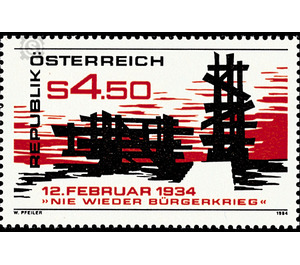No more civil war - Austria / II. Republic of Austria 1984 - 4.50 Shilling
Theme: Architecture
| Country | Austria / II. Republic of Austria |
| Issue Date | 1984 |
| Face Value | 4.50 |
| Color | multi-colored black |
| Printing Type | Photogravure |
| Stamp Type | Commemorative |
| Item Type | Stamp |
| Chronological Issue Number | 1109 |
| Chronological Chapter | OOS-OE2 |
| SID | 289741 |
| In 76 Wishlists | |
On February 12, 1934, fighting began in many places in Austria, especially in Vienna, between supporters of the Social Democratic Party and executive organs. In the course of these conflicts, about 300 people were killed on both sides. The so-called "Schutzbund", members of the Social Democratic Party, were defeated and sentenced to death by their leaders and immediately executed. The tragic events around the 12th of February 1934 are causally connected with the downfall of the Danube Monarchy and the founding of the Republic of Austria at the end of the First World War. A revolutionary wave emanating from Russia led to the establishment of democratic republican forms of government. After the separation of the various nations, the Republic of Austria remained, a small state of 6 1/2 million inhabitants. A grand coalition of representatives of citizens, peasants and workers took over government affairs for the time being under the chairmanship of Dr. Ing. Karl Renner, a leader of the Social Democrats. But the continued bad economic situation led to the rural and bourgeois classes rebelling against the long-overdue social reforms introduced under social-democratic pressure. Eventually, the parliament was dissolved and an authoritarian estates state was introduced under Dollfuss. When he fell victim to the coup attempt of July 25, 1934, the road to National Socialist rule in Austria was free. In the concentration camps of the National Socialists, the opponents of yesteryear, commoners and social democrats found themselves together as prisoners. The years of peaceful construction in the Second Republic owe much to the doctrines of the 12th of February, 1934, above all to the insight that Bruno Kreisky formulated: that it is more useful and more important, instead of dying for an idea, to live for them.


